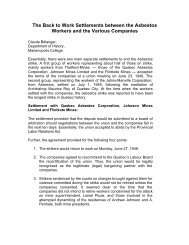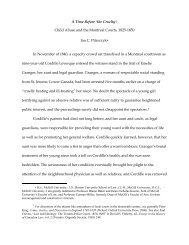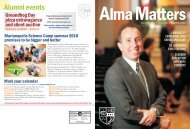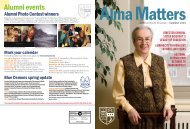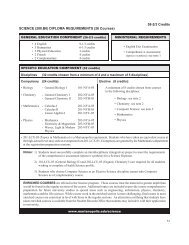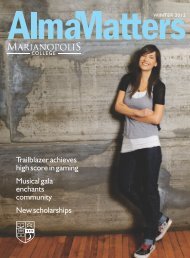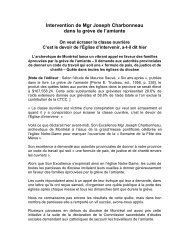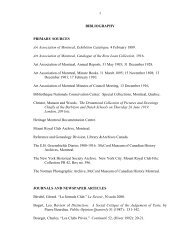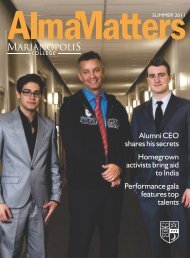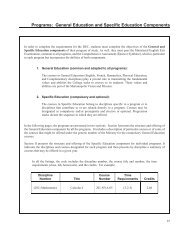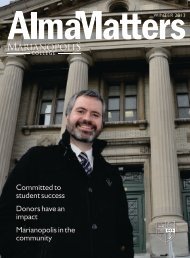2012-2013 Academic Year Calendar - Marianopolis
2012-2013 Academic Year Calendar - Marianopolis
2012-2013 Academic Year Calendar - Marianopolis
You also want an ePaper? Increase the reach of your titles
YUMPU automatically turns print PDFs into web optimized ePapers that Google loves.
Creative Arts, Literature and Languages: Arts and Letters - Art HistoryArts and Letters (502)Arts and Letters courses provide awide-ranging survey of culturalhistory and encourage students tothink about and participate incontemporary culture.Perspectives in Arts and Letters I502-LPA-MS (3-1-2) 2 creditsPerspectives I presents major currentsin the visual arts and architecture,literature and music from theRenaissance to Romanticism(1400–1850). Context—historical,intellectual and cultural—isemphasized as a means to analyzethe development of the various artsand to understand how the differenttypes of artistic production of a givenperiod relate to one another.Perspectives in Arts and Letters II502-LPB-MS (3-1-2) 2 creditsA continuation of the survey of thevisual arts and architecture, literatureand music offered in Perspectives I,Perspectives II focuses on majorcultural currents from the midnineteenthcentury to the present.Integrative Project: Creative Arts,Literature and Languages502-LSA-MS (3-1-2) 2 creditsIn their final semester, CALLstudents plan and carry out a selfdirectedintegrative project to bepresented during the college’s annualArtsFest. The development of thisproject requires the integration ofskills and knowledge acquired in atleast two disciplines from the specificeducation component of the CALLprogram. Beyond this requirement,students are free to choose their owntopics and means of expression:projects can take the form ofacademic, artistic or literary works.In addition to working on their ownprojects, students collaborate toorganize, advertise and execute thepublic presentation of these worksduring ArtsFest. Because the courseis run as a seminar/workshop wherestudents offer feedback and supportfor the work of their peers, activeparticipation and the exercise ofcritical skills are essential to success.Digital Music Technologies502-LFC-MS (3-0-3) 2 creditsThis course introduces studentsto contemporary digital musictechnologies. It includes coverageof both theoretical technicalinformation and the applicationof hands-on creative techniques.Students are also presented withsamples of existing artistic works.Topics may include audio editing andmixing, digital signal processing,audio effects, mashups, laptopperformance, sound synthesis,digital DJ techniques, sonfication,interactive audio installations anda broad overview of various musictechnologies. No specific backgroundtraining other than a good generalfamiliarity with computers and aninterest in music is required.Art History (520)Art historians study the historicaldevelopment of the visual arts—painting, sculpture, architecture,photography and more—byexamining the materials, techniques,forms and subject matter chosen byartists while taking into account thevarious contexts in which art isproduced. Understanding the social,intellectual, religious and politicalconditions under which artists livedand worked allows us to gain agreater understanding of how art canreflect, as well as affect, other areasof human life. Courses in Art Historyoffer students the opportunity toexpand their visual literacy and tolearn how to describe and interpretworks of art: important skills in anincreasingly image-based culture.Ancient Art520-LEA-MS (3-0-3) 2 creditsAn introduction to the primarilyWestern visual arts produced between15,000 B.C.E. and C.E. 500,beginning with the monuments ofprehistoric visual cultures and theworks of the Near Eastern cultures inMesopotamia and Egypt. Emphasis isplaced on the development of the artsin Ancient Greece and Rome, whoseclassical periods left an importantlegacy to later European art andarchitecture.Thematic Studies In History of Art:Medieval and Renaissance Art520-LEB-MS (3-0-3) 2 creditsAn increasingly humanistic worldview began to emerge in WesternEurope between the eleventh and theearly sixteenth centuries, or in arthistorical terms, from Romanesqueto High Renaissance. The ways inwhich humanism affected the riseof naturalism, individualism, andclassicism in the arts provides acentral theme for students learning tounderstand the differences betweenthe later Middle Ages and theRenaissance in painting, sculptureand architecture.Art: 16th to 19th Century520-LFA-MS (3-0-3) 2 creditsBy examining the history of Europeanart from the end of the Renaissancethrough to nineteenth-centurymodernism in the context of thepolitical, religious, social andintellectual conditions of the time,students learn to identify the effects77



